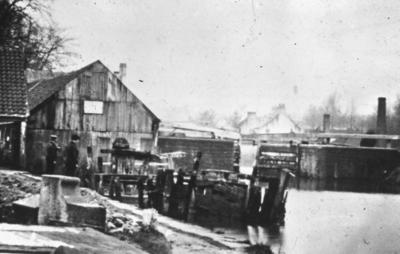Sites and Monument Record: Tophill Boatyard (SMR 1169)
Description
Complex comprising a graving dock, carpenter's shop, blacksmith's shop, stables, etc on the south bank of the Forth & Clyde Canal.
Although listed in 1979, the stables were demolished in the early 1980s. The dry dock had been filled in by 1880 and nothing now remains to be seen above ground.
See full details
Object detail
It seems that nothing was done to improve this entry until c1808 and a plan of 1807 shows the "dock" as a mere wharf. However, in that year two new passage boats, the Margaret and the Charlotte were commissioned. These were built by Hugh Baird at Tophill and were ready for service in May 1809. They were 58 and 60 feet long respectively. In 1812 the Canal engineer's report states that "At Camelon or Tophill is a small dock formed in the south Bank of the Canal, but not built, for repairing the Company's own boats in, which answers the purpose very well." Clearly it had still not been lined at this date.
Thereafter the yard was busy repairing and modifying the canal boats as well as new construction. Most of this work was supervised by William Stiven. In 1812 the Shamrock was launched and in 1815 the Star was completed. Then in 1822 Thomas Wilson was appointed Resident Engineer at Tophill and Overseer at the east end of the Canal. Wilson was already famous as the builder of Scotland's first iron vessel, the Vulcan, in 1819. In 1824 a blacksmith's shop was erected at Tophill and in that same year Wilson completed two iron scows there. The following year the Cyclops was built as the consort of the Vulcan. 1827 saw the iron goods boat Etna. The yard was very busy with this and repair work. Lock gates were also made here. Now they also undertook experimental work on steam propulsion, with technical advice from William Fairburn of Manchester. One outcome of this was the building of the stern paddle steamer Edinburgh at Tophill in 1831. Then, in quick succession, followed two light iron passage boats, the Rapid and the Velocity, neither of which were a success. The yard was well established and in 1831 a boatbuilding shed and a large shed for storing timber and lock gates were added to the accommodation. In 1836 two iron lighters for the Alloa trade were built at a cost of £600. Thereafter much of the work appears to have been repair and alterations. In 1838 Wilson was transferred to Grangemouth to supervise the building of the new dock there and the Tophill Yard was slowly wound down. By the time of the 1860 OS map it had reverted to a wharf.


Public comments
Be the first to comment on this object record.